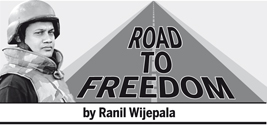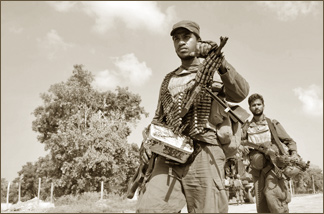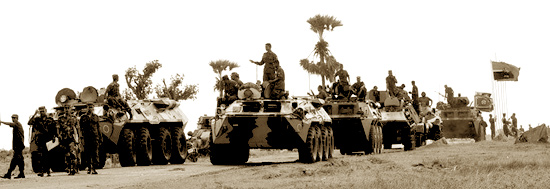|
How security Forces liberated the South and West of
Batticaloa :
When Chenkaladi-Maha Oya Road fell under troops control
 The
Sri Lanka military proved its metal in January 2007 with the liberation
of Vakarai from the clutches of the LTTE, effectively facing all the
challenges posed by the LTTE to thwart the efforts of the military to
capture that strategic stronghold. The
Sri Lanka military proved its metal in January 2007 with the liberation
of Vakarai from the clutches of the LTTE, effectively facing all the
challenges posed by the LTTE to thwart the efforts of the military to
capture that strategic stronghold.
 Although the Security Forces achieved their successes since Mavil Aru
operation the common masses of the country were not aware what was going
on in the battle front. Even though they were aware that the military
was on winning game they believe them with little bit of suspicion in
their minds. Although the Security Forces achieved their successes since Mavil Aru
operation the common masses of the country were not aware what was going
on in the battle front. Even though they were aware that the military
was on winning game they believe them with little bit of suspicion in
their minds.
The immediate factor behind that situation was that the strategies
adopted by the Army troops were completely a novel experience for them
as they used to hear military operations in Kilinochchi, Mullaitivu,
Elephant Pass, Mankulam, Nedunkerni in 1990ís with a massive number of
deaths of soldiers.
Therefore, many rumours were spread all over the country raising
doubts about the military victory in Vakarai too as they did not hear
any news about large number of deaths in the military during these
operations. So those victories were unbelievable for them.
Disgruntled politicians in the Opposition started to ridicule the
military victories in political stages. But, the Government was in a
firm stand to continue its military strategy to defeat the LTTE
terrorism whatever the undue criticism it had to face.
President Mahinda Rajapaksa, Defence Secretary Gotabhaya Rajapaksa
and the three Forces Commanders appealed them not to let down the
military victories. But, they were not shaken by those criticism as they
were aware of the real truth and also they were aware of the fact that
they were marching on the correct path.
However, huge publicity given to the cache of LTTE weapons recovered
from Vakarai area and the liberation of the civilian population from
Vakarai gave some sort of confidence for the general public to trust the
words of the military rather than the versions of the disgruntled
politicians.
Army Commander Lt. General Sarath Fonseka was confident of his
military plan for the East. He adopted small teams operations instead of
launching massive operations confronting the LTTE in huge scale. The
small team operations were helpful in the Vakarai operation to liberated
civilian population from the clutches of the LTTE without causing any
civilian deaths. At the same time the Security Forces also could
maintain a lower figure on casualties and deaths during these
operations.
The only opetion the LTTE had to face this situation was the booby
traps and the mines as they were not aware of the troops approach to
their territory.
Following the capture of LTTE stronghold at Vakarai on January 19,
2007 and later the areas around including Verugal, and the subsequent
opening of the Trincomalee-Batticaloa Road to the government control,
marked the end of an important phase in the Eelam War-4.
The Special Forces Brigade under the command of Colonel Prasanna de
Silva did the leading role in the operations in Sampur and Vakarai. By
this time the Army was in need of more and more troops to consolidate
and dominate the areas they have captured. Army Commander with the
consultation of Defence Secretary Gotabhaya Rajapaksa were planning out
their recruitment drive to increase it strength.
 However, the military could not wait, until it get its required
strength. The LTTE cadres who fled from Vakarai towards Baronís Cap or
Thoppigala area and in the West of Batticaloa were intensifying their
terror activities in that area. Therefore, Army Commander Lt. General
Sarath Fonseka decided to hand over the next operation for the Commando
Brigade. However, the military could not wait, until it get its required
strength. The LTTE cadres who fled from Vakarai towards Baronís Cap or
Thoppigala area and in the West of Batticaloa were intensifying their
terror activities in that area. Therefore, Army Commander Lt. General
Sarath Fonseka decided to hand over the next operation for the Commando
Brigade.
The elite Commandos of the Sri Lanka Army supported by the seventh
battalion of the Sri Lanka Light Infantry (7SLLI), sixth, seventh and
the eighth battalions of the Gemunu Watch (6,7 & 8 GW) who were directly
under the Army Commander were entrusted with the next phase of the
operation to liberate the South and West of Batticaloa.
This time the major focus of the Security Forces was to capture areas
west and south of Batticaloa upto the road stretch between Pullimulai to
Chenkaladi on the Badulla-Maha Oya-Chenkaladi A-5 Road which was under
LTTE control for more than 14 years since 1994.
The area under the focus of the Security Forces was located west of
the Batticaloa-Akkaraipattu A-4 Road and south of the Batticaloa -
Trincomalee A-15 road. The area demarcated for the Security Forcesí
humanitarian operation was populated by nearly 75,000 people.
The Police Special Task Force was in control of the A-5 Maha Oya
Chenkaladi road upto Pullimulai from the Maha Oya side and the Security
Forces had control up to Black Bridge from the Chenkaladi- Batticaloa
side. The road stretch between Pullimulai to Chenkaladi was under LTTE
control.
The area located east of the Chenkaladi Maha Oya road and west of
Batticaloa was the lifeline for Tiger terrorists operating in Thoppigala
jungles, as it provided much needed logistics support and manpower
through their forcible recruitment drives.
The Tigers also made use of this area to de-stabilise the Security
Forces in Vavunathivu, Sathurukondavil, Mailambaveli, Sittandi and
Kaluvankerni through intermittent mortar fire.
The LTTE also launched a mortar attack on the helicopter carrying
Western diplomats to Batticaloa when it landed at the Weber Stadium in
Vavunathivu, in February 2007 from this direction.
Under these circumstances it was essential for the Security Forces to
neutralise Tiger threats coming from this direction using the handful of
mortar launchers located there, threatening the lives of both civilians
and also of the Security Forces.
According to Security Forces estimates, the Tigers had used a few 120
mm mortar launchers, and a 100 mm Mon Gun located in this area to launch
attacks on the Security Forces.
Therefore, it became crucial for the Security Forces to capture this
area to take full control of the Eastern population thus paralyzing
Tiger activities, which are now confined to the Thoppigala or Baronís
cap jungles.
Thousands of civilians left their villages in the west and south of
Batticaloa isolating the Tiger cadres in the area, enabling the Security
Forces to liberate the area with zero casualties to the civilian
population. The same pattern was witnessed during the Vakarai operation.
An estimated 65,126 civilians left the area before the Security
Forces humanitarian mission to liberate the area and took shelter at the
IDP centres in cleared areas in the Batticaloa district adding to the
number of civilians living in the district after being displaced from
areas in Trincomalee.
It has again turned into a battle fought by the Security Forces in
the Eastern theatre, using their strategies and tactics to counter the
guerrilla warfare of the Tiger outfit taking cover under the civilian
population to thwart military operations to liberate the Tamil
population.
The Security Forces again averted face-to-face confrontations with
the Tigers, deviating from the earlier practices to capture uncleared
areas putting the LTTE to the level of a conventional Army.
On February 24, elite Army commandos were inducted into the area from
the southern direction from Kohombagastenna in the Ampara - Batticaloa
district border to launch a lightning assault on the Tiger cadres
manning the area. It was completely a surprise move for the LTTE as they
were expecting the troops either from Maha Oya side, Chenakalai or
Vavunativu area. The infantry troops from the four infantry battalions
were also inducted to consolidate the areas captured after flushing out
LTTE cadres.
Then troops moved in small groups in a northern direction clearing
Tiger threats until they captured strategic Vavunathivu from the Tiger
grip on March 25. A major confrontation was reported from the
Unnichchiya tank area on March 8 in which six terrorists were killed and
20 others injured.
After the capture of strategic Vavunathivu from the Tiger grip,
troops extended their operation to clear Kokkadichcholai, Kurukkalmadam,
Appalamthurai, Mavalimunai and Vellaveli. The Kokkadicholai Tiger nerve
centre fell to the Security Forces on March 28.
The capture of the Kokkadicholai was the landmark of this operation
as troops could capture sophisticated conference halls, medical centres
and a large haul of weapons from this nerve centre of the Eastern
Command of the LTTE. In the face of the advancing Light Infantry troops
of the Sri Lanka Army, the Tigers left most of their weapons and fled.
The Army also described the camp as the point of origin of artillery
attacks directed against the diplomatic officials and Minister Mahinda
Samarasinghe in which US and Italian ambassadors were injured.
With the fall of Kokkadicholai, troops took a large area south and
west of Batticaloa town under their control after creating a sort of a
defence line connecting Vavunathivu and Unnichchiya areas covering the
A-5 road from the Eastern sector.
Then onwards the troops continued their humanitarian mission to
capture the A-5 Chenkaladi - Maha Oya road with the task of liberating
the area to facilitate the return of the civilian population displaced
from the area and enabling people to travel from Batticaloa to Badulla
using the shortest possible road.
They succeeded in their efforts on April 11,2007 afternoon after
taking full control of the Badulla - Maha Oya - Chenkaladi road
confining an estimated 200 to 300 Tiger cadres to a 150 square kilometre
jungle patch in Thoppigala.
The happy news came as the country was preparing to celebrate the
Sinahala, Tamil New Year.
During the whole operation, according to Security Forces, 180 LTTE
cadres were confirmed killed and 133 LTTE were wounded. The figure had
been finalised through the recovery of LTTE bodies and through
intercepted radio transmissions of the LTTE and through the statements
of LTTE cadres who surrendered.
The areas captured by the Security Forces were handed over to the
Police Special Task Force and the Police to maintain law and order in
the area and to facilitate the resettlement of displaced civilians.
Though the mission appeared to be a simple operation for outside
observers the Security Forces had to take strategic decisions to make
their mission successful.
First they had to take care of the nearly a 100,000 civilian
population who had been displaced from their villages while facing
severe criticism from various quarters of society over the displaced
civilians.
However, the Security Forces were able to manage all those pressures
and also thwart desperate LTTE attempts to blow off their defences using
suicide cadres to make their mission successful.
The LTTE also directed mortar fire on civilians in Santhiveli,
Sittandi and Morakotachchenai areas killing eight civilians and injuring
25 civilians.
Through the successful completion of the last lap of the Security
Forces mission in the East, they have been able to take full control of
the entire civilian population in the Eastern province bordering Yan Oya
in the North of Trincomalee and towards the southern tip of Ampara
district bordering the sea.
The LTTEís already diminishing presence in the east was reduced to a
mere 140 square kilo metres of jungle land in Thoppigala. Barans Cap or
famously known Thoppigala jungle area in Batticaloa close to the
Polonnaruwa district border is located, 220km east of Colombo.
LTTEís largest camp in the east, which is called the Beirut base is
located in this region. This base had been the heart of LTTE operations
in Batticaloa sector for a long time.
With the capture of the areas in the South and West of Batticaloa,
the troops later focussed on this strategic and famous Baronís Cap area
in fully eliminating the LTTE from the Eastern jungles. |

